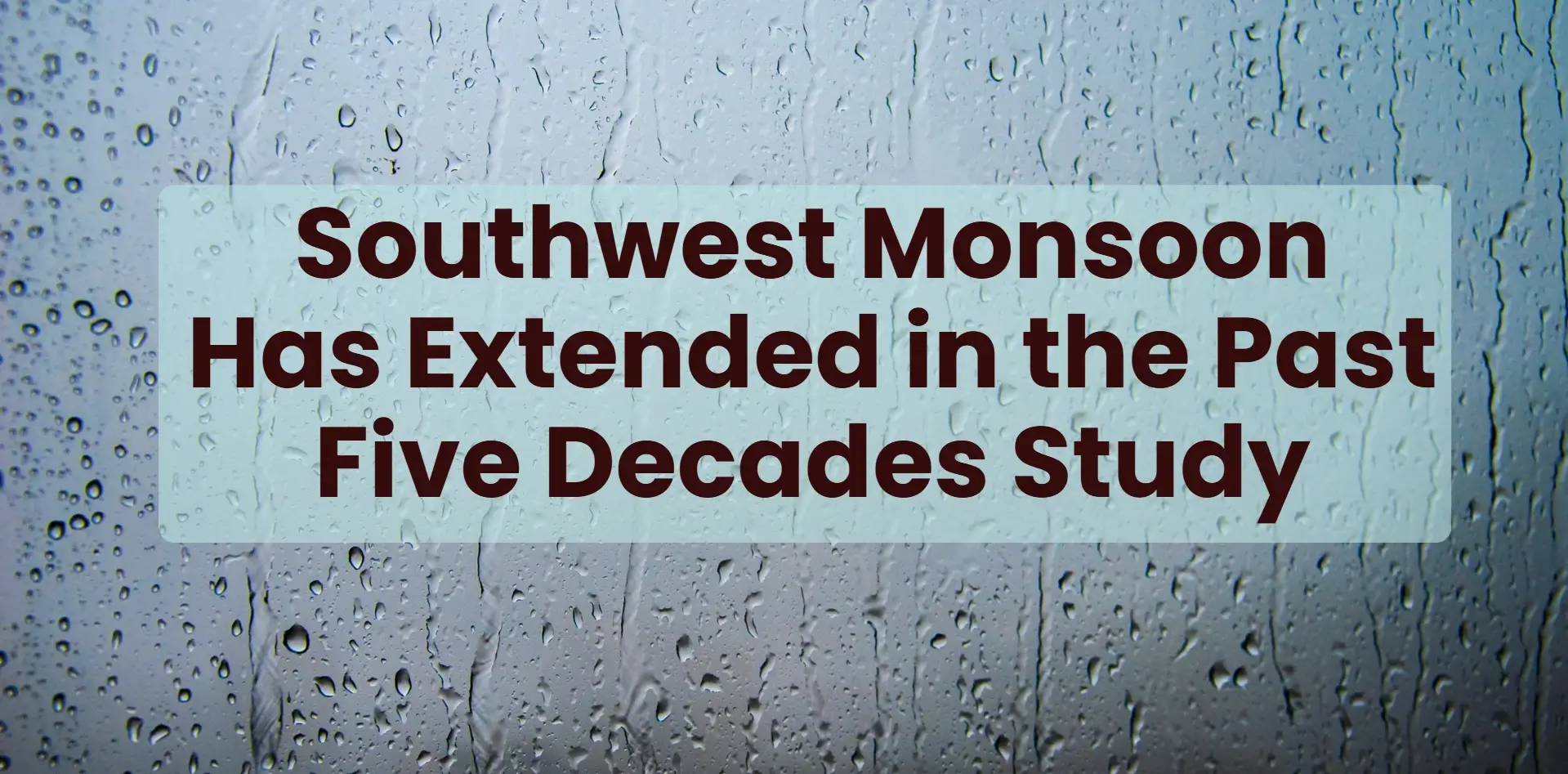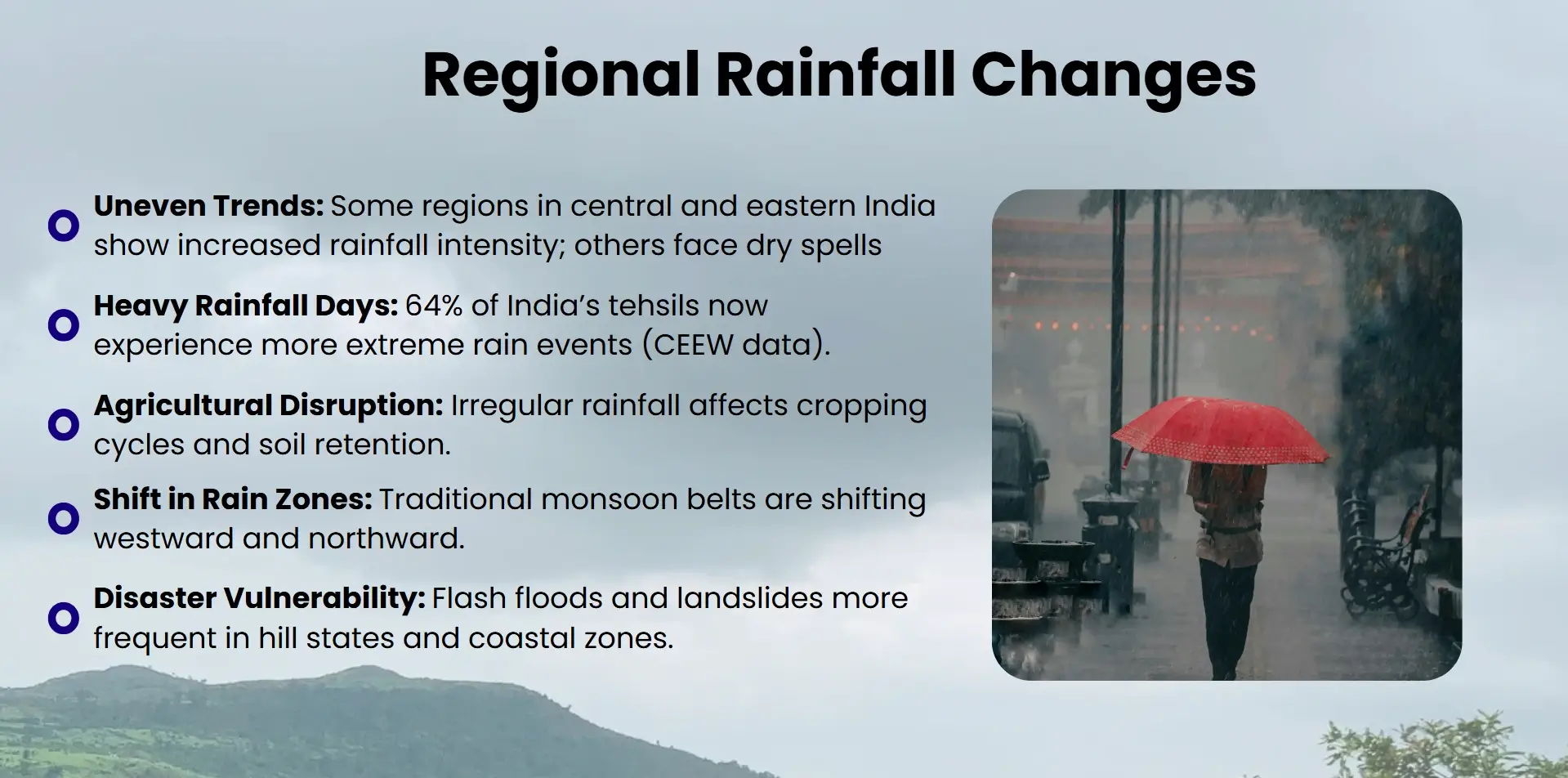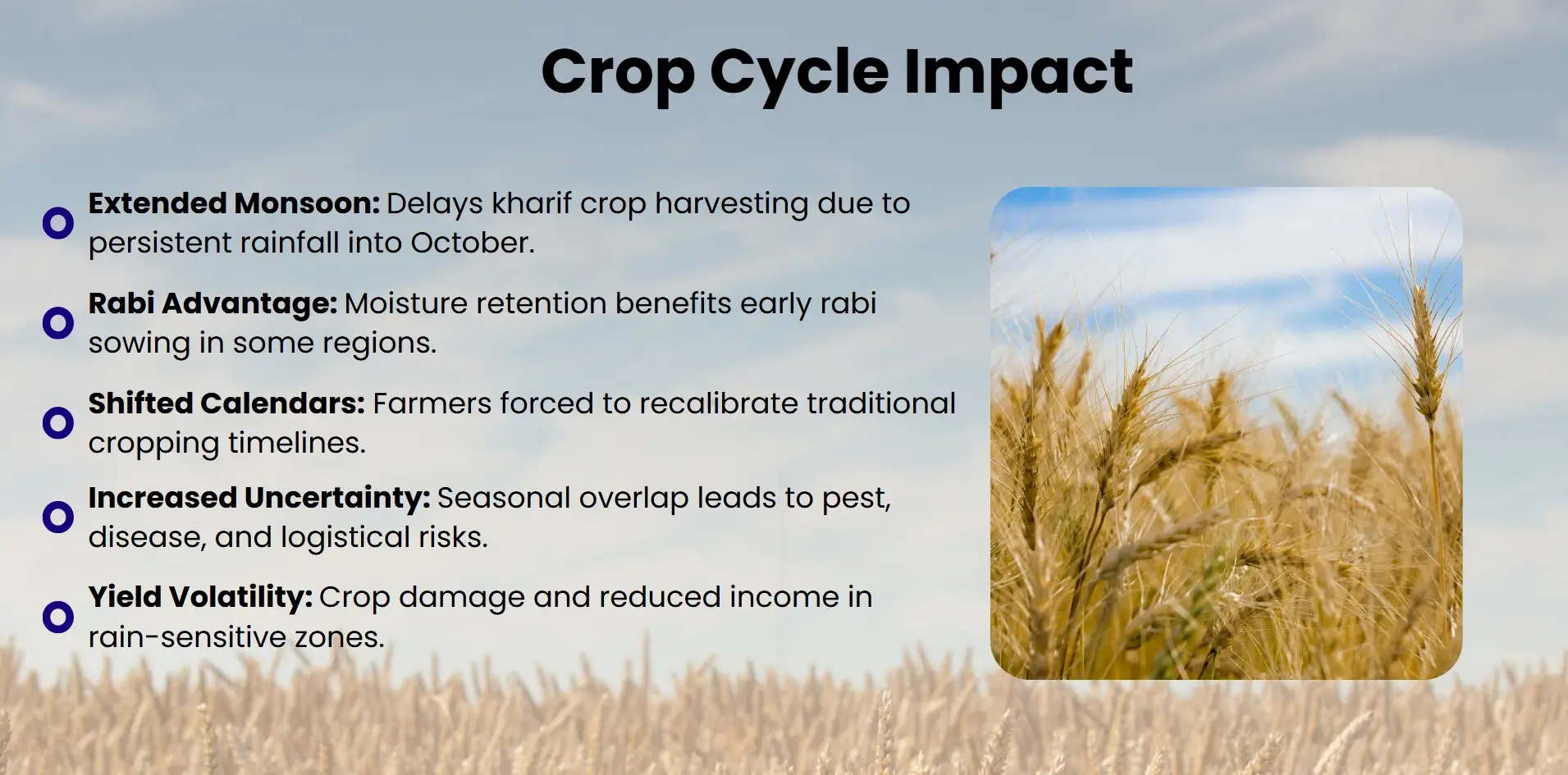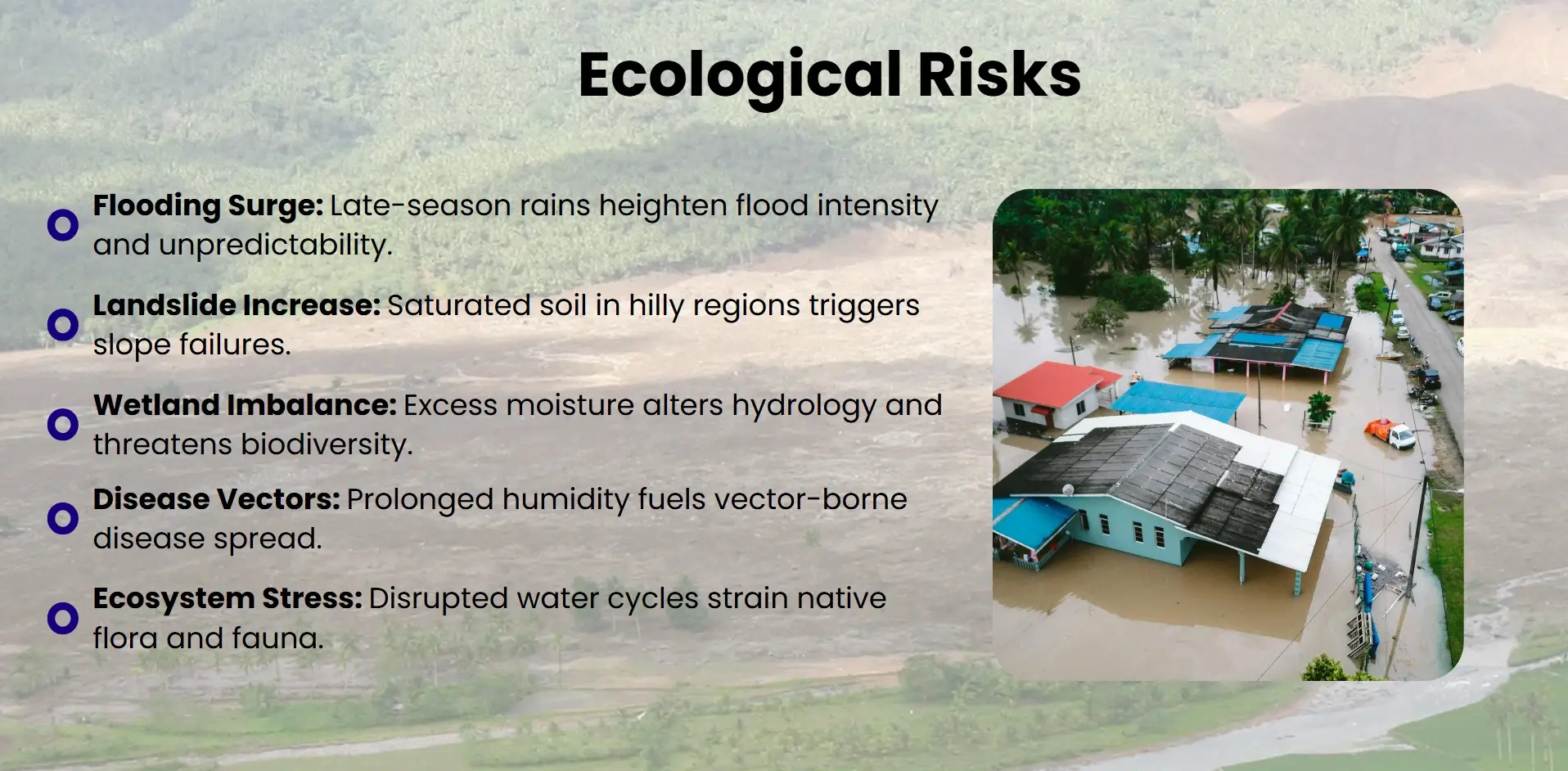A study by the India Meteorological Department reveals that the southwest monsoon season in India has extended by 1.6 days per decade over the past 50 years, increasing its contribution to annual rainfall from 75% to 79%. According to a recent study, the Southwest Monsoon in India has been increasing by 1.6 days every ten years since 1970 and this affects agriculture policies, climate-related processes, and water resource planning.

A lot more than just a season of the weather, the Southwest Monsoon signifies agriculture, water irrigation, and sustainability in the subcontinent of India. This is the period that usually takes about four months, between June 1 and September 30, and brings close to 75 percent of the entire annual rainfall needed by millions of farmers in the country, as well as renewal of essential ecosystems. But there is a small yet important change, according to recent scientific evidence, the monsoon season has been in an extension process over the last 50 years. As a result of research that evaluated information between 1970 and 2020, the Southwest Monsoon has lasted longer by around 1.6 days with every decade.This expansion, apparently very limited, has extensive consequences. It is symptomatic of more fundamental changes in atmospheric and oceanic dynamics-founded due to global warming and poses serious concerns about the future of climate predictability in South Asia. Be it modified farming routines and challenges concerning water supply, to the possibility of an upsurge in the flood-related risks and ecological imbalance, there is a dire need to tackle the changes occurring in the monsoon now, by policymakers, scientists, and the communities wherever possible. This articleanalyses the scientific premise of the research, historical developments, the social and economic as well as environmental impacts of prolonged monsoon months, and it provides the view of how India needs to respond to this new climate reality.
Scientific basis of the Research
The spread of the Southwest Monsoon season of India has been strictly tested with large scale meteorological data sets and climate indices. Carried out by scientists within India Meteorological Department (IMD), the research shows regular growth in the duration of monsoons in India-about 1.6 days per decade throughout the last 50 years (1971-2020).
Data Sources and Methodology
A gridded rainfall dataset was created using rain gauges and it includes the period between 1971 and 2020. The two reducing metrics include:
- MOK2WDRL:Rainfall occurrence between Monsoon Onset over Kerala (MOK) and withdrawal date
- JJAS: June (rain) -September (monsoon)season
The comparison of these two datasets revealed a growing disparity between the traditional JJAS period and the real-time rainfall durations; in other words, the study found that the rainy season is getting longer in most regions.
Climatic Drivers and Variability
In the study, it is found that extension is a result of late withdrawal dates as opposed to earlier dancing. The occurrence beginning over Kerala is displaying inter-annual variance, but it has not changed in a big way in a period of 50 years. But monsoon withdrawal has continued to shift to later dates in October.
The main climatic factors that contributed to such trend are:
- El Nino southern oscillation (ENSO): It changes the wind pattern and sea surface temperatures
- Indian Ocean Dipole (IOD): Alters the movement of moisture as well as precipitation levels of rainfall
- Global warming: Strengthens interaction between ocean and atmosphere leading to long-term wet seasons
Connection with the Indicators of Agriculture
Interestingly, the research employed showed greater correlations of MOK2WDRL rainfall and crop yields (e.g., rabi and mustard) with JJAS rainfall. This implies that the length of the monsoon season is perhaps more significant in terms of seasons that have to be considered by agricultural planning than the conventional boundaries of seasons.
Historical Trends and changes
The Southwest Monsoon has also experienced weak but quantifiable transformations on its time scale, intensity and its spatial distribution within the last 50 years. Such changes are a part of the wider-scale climatic changes and their consequences impact greatly on the ecological and economic structures of India.
Decadal Extension of monsoon
The monsoon season has been lengthened by some 1.6 days per decade between 1971 and 2020, mainly because of the later dates of withdrawal. There has been a great inter-annual variability in the onset over Kerala (MOK) but it has been stable. The withdrawal, however, has gradually become later and later in October such that active rainfall across most of the country has gradually extended.
Rainfall Variability and Extremes Changing
Distribution of rainfall has changed as well. Indian tehsil-level analysis by CEEW shows that 64 per cent of regions in India had an increase in heavy rainfall days during the Southwest Monsoon over the last decade. Historically arid regions such as Rajasthan and certain parts of Maharashtra recorded a statistically significant increase in seasonal rainfall, whereas in the lower River Indusplainsand the Indo-Gangetic plains as well as in the northeast India, early-season rainfalls fell short.

Violation of JJAS Norms
This is presented as a developing misfit between the historical JJAS (June-September) period of rainfall and real monsoon performance. Rainfall that contributes to annual rainfall between MOK and withdrawal (MOK2WDRL) is now 79%, up from 75% under JJAS. This variance emphasizes that the definition of the monsoons needs to change to have a better model of the climate and agriculturalstrategies.
Agricultural and Economic Consequences
The SW Monsoon season is extending, redesigning social, economic and agricultural roots of India.Most of the farmlands in India are dependent on rain. Thus, any marginal changes in the timelines of the Indian monsoons can wreak disproportionately large impacts.
Effect on Cropping and Yields
An extended monsoon period shifts sowing and harvest patterns particularly in crops, such as, rice, maize, and pulses that belong to kharif crops. Reduced speed of withdrawal may also result in waterlogging revolutionizing the maturity of the crops and post-harvest activities. On the other hand, prolonged rains could be useful to rabi crops such as mustard and wheat since their growth necessitates good soil moisture, and groundwater recharge.State farmers in areas such as Punjab, Bihar and Odisha are progressively shifting planting windows to favour random rain patterns.
Economic Ripple Effects
Agriculture accounts up to approximately 14 percent of the GDP of India and generates 42 percent jobs. An extended monsoon may increase the incomes of the rural populations by increasing the yields but may also increase the chances of flooding, crop destruction, and an outbreak in pests.In addition, other industries that are related to agriculture, namely food processing and textile industries; experience the fluctuations of the supply of raw materials. The financial outlays of aiding the farmers in times of intense events have increasingly increased, leading into demands of climate-resistant crop insurance against inflexible procurement policies.

Strategies and Opportunities
Reduced monsoon also offers potential investment in agroforestry, rainfall harvesting and crop varieties of short duration. Such government schemes as PMFBY and advisories are digital will be able to guide farmers through the uncertainty, but their perfection lies in the local implementation and climate literacy.
Ecological and Hydrological effects
The Southwest Monsoon is an extended event that is restructuring the Indian eco system and climatic processes in water. The changes are elusive yet are becoming evident in the countryside, cities and biodiversityhot-spots.
Surface water Stress and Groundwater Recharge
Long rainy seasons improve groundwater recharge especially in the semi-arid zones such as in central India and in a section of the Deccan Plateau. Nevertheless, this is an unequal benefit. Surface water stresses occur in flood-prone areas due to surplus runoffs that stress the reservoirs and ruin irrigation schedules. Asynchrony in rainfall and water storage infrastructure usually leads to poor harvesting of water resource and seasonal water scarcities.
Biodiversity and Wetland Modifications
The wetlands, which rely on the regular hydrological balance, are undergoing changes in the inundation process. Long spells of monsoons may retard periods of drying out, which influences patterns of migratory birds and water ecosystems. In ecologically sensitive places such as Sundarbans and Chilika Lake, salinity gradient has been altered due to long wet conditions that have affected mangroves and fish breeding.
Greater Threat of Floods and Landslides
Monsoon withdrawals also being delayed increase the effect of late season floods, more commonly in river basins such as the Brahmaputra and Ganga. States like Himachal Pradesh and Uttarakhand witness landslides as a result of excess water and landslides on unstable land. Cities, too, are overwhelmed by drain fills; cities such as Mumbai and Bengaluru have plenty of waterlogging and infrastructure burden.

Need for Ecological Resilience
These changes in hydrology require adaptation measures using ecosystem approach- afforestation, saving wetlands and making urban planning climate-smart. Long-term risks can be reduced by making the early warning systems stronger and incorporating ecological information into forecasting the monsoons.
Response of Policy and Planning
When the Southwest Monsoon season is extended, the climate control, cultivation schedules, and disaster prevention of India need to be adjusted.
Upgrading Forecasting System
The improved performance of forecasting monsoons in India, as seen in India Meteorological Department (IMD) functions is because of Multi-Model Ensemble (MME) and climate forecasting system of the Monsoon Mission (MMCFS). These models combine global climatic data so as to forecast the start, end and space distribution of rainfall during the monsoons with more enhanced accuracy. There has been improvement in regional planning and early warning systems through the 21 percent reduction of forecast errors over the last 18 years.
Adjustments to Agricultural Policy
The awareness of the gap between the conventional JJAS rainfall and the real monsoon activity triggers the need to promote dynamic agro-climatic zoning, according to the experts. This comprises updating the sowing calendar, boosting short-duration crop strains and in addition, and increasing climate-resilient insurance plans such as PMFBY. The Ministry of Agriculture is also looking into the possibility of having a flexible procurement calendar to adjust to changing harvests.
Infrastructure and Climate Adaptation
In 2024, a new initiative was initiated by the government called Mission Mausam, which is supposed to transform India into a weather-ready and climate-smart nation. It covers ecosystem-based adaptation, upgrades of urban drainage, and community-level resilience. The states are advised to mainstream monsoon variability in State Action Plans on Climatic Change (SAPCCs) with a tendency of emphasis on flood control, wetland conservation and optimized water storage.
Evidence-Based Governance
With this new trend towards shifting the JJAS to MOK2WDRL rainfall metrics, planners and researchers are showing interest. This advanced method makes it easier to predict the extent of crop production, the availability of water, and the chances of disaster, which policies can integrate with the changing climatic situation.
Conclusion
Slow and steady lengthening of the Southwest Monsoon in India (1.6 days over the past 40 years) is not just a weather phenomenon; it is an indication of more profound climate changes leading to some vast ramifications. Whether it is a shift in agricultural cycles and environmental imbalances or increased flood threat and planning, the changing monsoon requires a recalculation of the established infrastructure. Scientific facts have given weight to the argument that working within the strict definition of JJAS is no longer suitable and a more dynamic and data-informed methodology, such as MOK2WDRL metrics, must be considered.In this new climate reality in India, in which all-out war with monsoons appears unlikely to win, monsoon variability will have to be considered in policy, infrastructure, and community resilience. The adaptive enhancement of warning technologies, adjustment of cultivation schedules and other eco-protective investments becomes not an option anymore rather it is anecessity. An altered pulse of monsoon provides India with chances as well as threats; along with how and whether it reacts to the rising stakes are the key to its environmental and economic destiny. Future survival in this era of climatic change will depend on continued interdisciplinaryresearch, and on reshaping governance to be more adaptive.